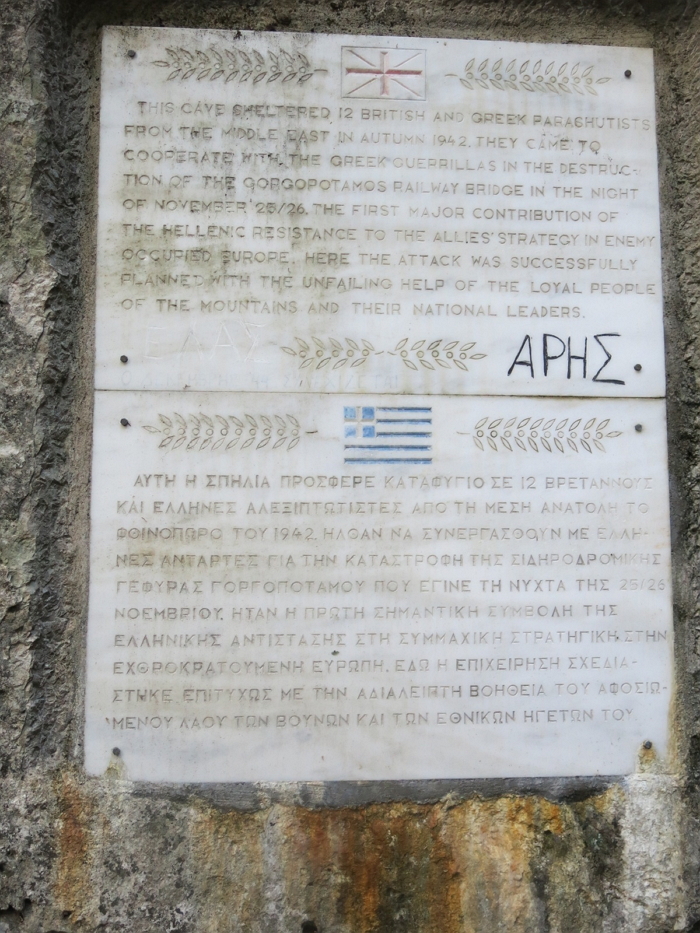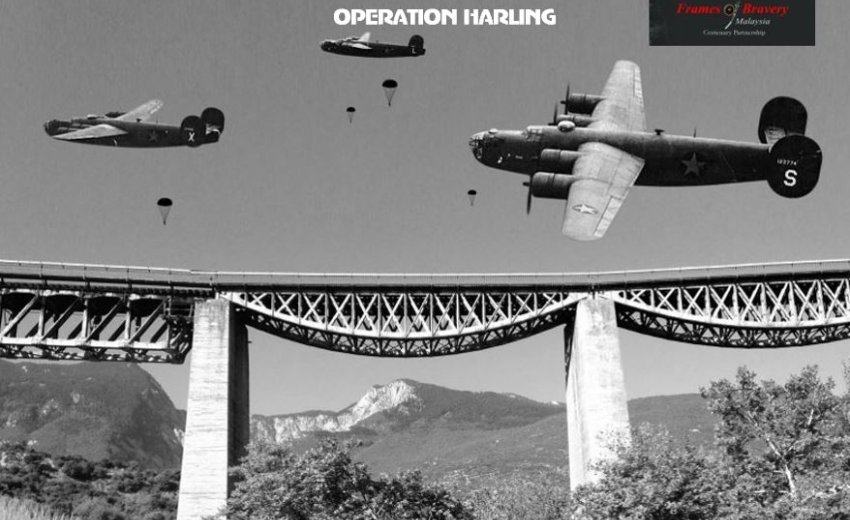Co-written by Harprabhjeet Singh Bedi
"We had a moment of panic when an old lady suddenly appeared on a ledge above and called loudly down to those below. "Get the sheep away from the bridge, the British are going to blow it up tonight," I was sure the plan was blown. But luck was with us and nobody but the shepherds understood Granny's words. However, since nobody told the enemy, our plans were not generally compromised!"
SOE Cairo, the secret command centre for subversive action, parachuted the Commonwealth commandos into the difficult terrain in Central Greece. Their task as "Operation Harling" was to destroy one of three railway viaducts on the line between Thessaloniki and Athens in order seriously to disrupt vital supplies getting through to Rommel's troops in Africa.
Greek roads were so bad they'd wear tank tracks out and supplies were always transported by train. In 1942, the main German supply route to North Africa was through Greece and it was a matter of great strategic importance that supplies were disrupted for several weeks before El Alamein.
In the night of 25th November 1942, the Gorgopotamos bridge on the Brallos pass (Thermopylae) in Greece was blown up. This operation was to have extensive consequences for the course of the war in the Balkans. The destruction of the bridge is celebrated to this day like a national holiday.
The sabotage mission was a major success for SOE, being the biggest such operation carried out until then. Although its original military objective, the disruption of supplies for Rommel's troops, had been rendered obsolete by the Allied victory at El Alamein, it did display the potential for major guerrilla actions in serving Allied strategic objectives, encouraged SOE to aid the development of resistance movements, and provided a major morale boost for occupied Greece.[21] In its aftermath, the Harling mission was not withdrawn, as originally envisaged, but instructed to remain on spot and form the British Military Mission to Greece.[19] Unfortunately for the Greeks however, it was the last time where ELAS and EDES, the country's two major guerrilla forces, would cooperate militarily; within a month, the first clashes between ELAS and EDES forces occurred, a prelude of the open conflict that would erupt between ELAS and the other resistance groups in 1943, and a herald of the Greek Civil War.[7]
Operation Harling was an important contribution to the success of the Allied attack and an Indian soldier's role long hidden in a chapter of history that very few know today and it needs to be recognized.
Serving Britain behind the German and Italian lines during World War II, Inderjit Singh a sapper and explosive expert was part of a campaign to foment resistance against the Axis powers in Greece and to cripple their transport arteries by blowing up key bridges. Leaving Greece, he served with the Royal Engineers on the slog from Cassino to Bologna, where he was injured twice in explosions, shrapnel from which he carried in his body for the rest of his life.
Inderjit Singh Gill was born in U.K. in 1919 to a Sikh Army doctor Gurdial Singh Gill and a Scottish mother Rena Lister.
Inderjit Singh joined the British Army as a volunteer during the Second World War Though he was born in the U.K., he studied in Madras because his father was the head of prisons there.
He was awarded the Military Cross on 3 February 1944 (London Gazette pg:620 3rd , February 1944 Lieutenant (acting Captain) Inderjit Singh Gill {229329), Corps of Royal Engineers (Edinburgh). as a Lieutenant, acting Captain for the Royal Engineers. He was commissioned into the British Army Corps of Royal Engineers as a Second Lieutenant on 5th April 1942. He was promoted to Lieutenant on 5th October 1942 and to temporary Captain on 21st May 1945 on 6th April 1944 as Lieutenant, Acting Captain for services in the Middle East. Lieutenant Inderjit who later became a Lieutenant General in the Indian Army.
The mission :~
On September 29, 1942 a group composed of twelve commandos, led by Colonel Eddie Myers and Hellenist Major Chris Woodhouse fell with parachutes in the Mount Giona, (Central Greece) Under-equipped and under-prepared but with courage to spare, their initial mission was to blow up a key railway bridge, cutting Rommel's supply lines to North Africa, where the battle of El Alamein was about to begin.
The wind blew them off-course and they landed in Lamia town square, with the Italians racing to grab them before they escaped (everybody had been watching them slowly descend for several minutes). Luckily, the Lamians got there first and quickly shuttled them from one house to the other as a search started, and a game of 'hide the Brit, or pass the parcel' ensued for the next few hours, until the new arrivals were smuggled out.
Operation Harling was only the start of a lengthy and perilous clandestine mission.
The SOE party for 'Harling' totaled 12 men divided into three groups each comprising the leader, interpreter, sapper and radio operator: the first group comprised Myers, Captain Denys Hamson as interpreter, Captain Tom Barnes as sapper and Sergeant Len Wilmot as wireless operator; the second group comprised Woodhouse, 2nd Lieutenant Themis Marinos, Lieutenant Inderjit Singh , and Sergeant Doug Phillips; the third group comprised Major John Cook, Captain Nat Barker, Captain Arthur Edmonds and Sergeant Mike Chittis. Each group was delivered by a Consolidated B-24 Liberator aeroplane. Three viaducts were targeted, all in the Brallos area : The Gorgopotamos, Asopos and Papadia bridges. The destruction of the Asopos viaduct was preferable, since it would take longer to rebuild, but the choice would be ultimately left to the mission's leader.
On the mountain, looking down onto the bridge, was the large Ghiona cave, where all explosives and andartes were hidden until the attack started. For a whole day the men waited, watching the activity below and putting the finishing touches to the attack plan. It was decided, then, in October, to hit the Gorgopotamos Bridge, a curved structure that would be the most difficult to repair.

The attack was planned to take place at 23.00 on 25 November. Two teams of eight resistance fighters were to cut the rail and telephone lines in both directions, as well as cover the approaches to the bridge itself, while the main force of 150 guerrillas was to neutralize the garrison. The demolition party, divided into three teams, would wait upriver until the garrison had been subdued, and then lay its charges.
Gorgopotamos viaduct was guarded by 100 Italian and five German soldiers. The guard had heavy machine guns and the neutralization of the men required very quick action by the Greek patriots and the British agents.
At 11:07 on the evening of November 25 started the attack on the garrison at both ends of the bridge. Everything was developed according to the plan and at 1:30 in the morning of November 26 blew up a section of the bridge to follow at 2:21 the blowing half, and as a result the bridge was out of order. Meanwhile, a train with Italian soldiers blocked by the Greek rebels and was unable to provide assistance.
At 4:30 in the morning and the last guerrilla man had left the area of sabotage with final destination the site Kalyvia, the meeting place of patriots. Of the 150 men who brought out the "Operation Harling" only four wounded, while the garrison of the bridge lost 20-30 soldiers. In retaliation, a few days later at the site of the destroyed bridge were executed nine Greek patriots!
Initially the twelve British commandos were supposed to be brought back to Africa. However, evacuation became impossible, so SOE headquarters in Cairo ordered them to stay in the Greek mountains as liaison officers and to train the rapidly growing number of andartes in partisan warfare and to equip them with money and weapons.
The reconstruction of the Gorgapotamos viaduct and resumption of freight services along the line in January 1943 meant a new effort was needed to once again hinder Axis supplies. Colonel Eddie Myers gave a new codename 'Washing', to the proposed operation to destroy the Asopos railway viaduct in the area of central Greece to the north-west of Athens (20 June 1943).
Lt. General. Inderjit Singh, PVSM, MC; is a legend in the Indian Army but little known outside it.
Resource:-
1) 'Born to Dare' (The Life of Lt. Gen. Inderjit Singh Gill PVSM MC by S. Muthiah )
2 https://en.wikipedia.org/wiki/Operation_Harling
3) http://codenames.info/operation/harling/
4) London Gazette pg:620 3rd , February 1944
5) https://southwestsun.files.wordpress.com/2011/09/april-20_2008_moushumi.pdf
6) Operation Harling : https://www.youtube.com/watch?v=iJk4tcwudVw
